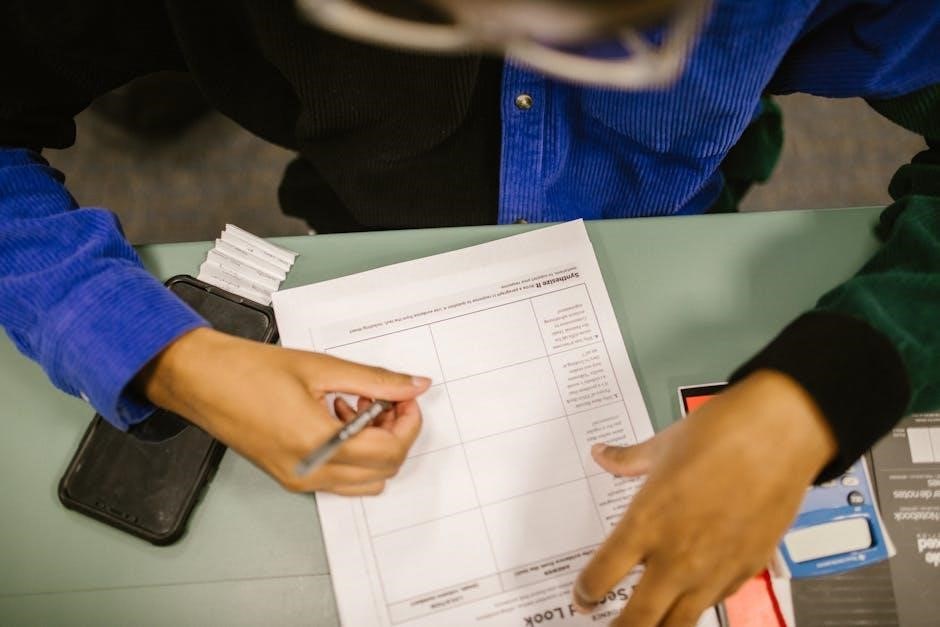The School Function Assessment (SFA) is a criterion-referenced tool developed by Pearson for students aged 5-12, evaluating their performance, participation, and support needs in school settings. Completed by educators and parents, it aids in identifying functional skills, informing IEP development, and monitoring progress, ensuring tailored support for students with disabilities.
1.1 Overview of SFA and Its Importance
The School Function Assessment (SFA) is a criterion-referenced tool designed to evaluate students’ functional skills necessary for participation in elementary school activities. Developed by Pearson Education, it focuses on three key components: participation, task supports, and activity performance. The SFA is essential for identifying students’ functional needs, informing Individualized Education Programs (IEPs), and monitoring progress over time. It provides educators and parents with a comprehensive framework to support students with disabilities, ensuring their successful integration into academic and social environments. Its importance lies in its ability to tailor interventions to individual needs, promoting inclusivity and educational success.
1.2 Brief History and Development of SFA
The School Function Assessment (SFA) was developed in 1998 by Pearson Education, Inc., to address the need for a comprehensive tool to evaluate students’ functional skills in school settings. Designed for students aged 5-12, the SFA focuses on participation, task supports, and activity performance. Its creation aimed to provide educators and parents with a structured framework to identify functional needs, inform IEP development, and monitor progress. This tool has become a cornerstone in special education, helping to ensure students receive tailored support for success in academic and social environments.

Structure and Components of SFA
The School Function Assessment (SFA) evaluates students’ functional skills through three scales: Participation, Task Supports, and Activity Performance, providing a comprehensive framework for assessing school-related abilities.
2.1 Participation Scale
The Participation Scale evaluates students’ involvement in school activities, focusing on their initiation, interaction, and independence. It assesses how consistently students engage in tasks, requiring judgment from educators or parents. Scores range from 1 (no participation) to 4 (consistent participation), helping identify supports needed. This scale is crucial for understanding students’ ability to actively contribute to their educational environment, ensuring tailored interventions are implemented to enhance their engagement and overall school experience.
2.2 Task Supports Scale
The Task Supports Scale measures the level of assistance students require to complete school-related tasks. It evaluates the type and frequency of support, such as physical aid or prompts, needed for activities like using materials or following rules. Ratings range from 1 to 4, with higher scores indicating greater independence. This scale helps identify specific accommodations necessary for students to perform tasks effectively, ensuring personalized support and fostering an inclusive learning environment tailored to individual needs.
2.3 Activity Performance Scale
The Activity Performance Scale evaluates students’ ability to execute tasks independently, focusing on academic and functional activities. It assesses performance across tasks like handling materials, following instructions, and interacting with peers. Each skill is rated on a 4-point scale: 1 (no performance), 2 (partial), 3 (inconsistent), and 4 (consistent); This scale identifies how well students perform daily school tasks, helping to pinpoint areas needing improvement and inform targeted support strategies to enhance their functional capabilities and academic engagement.
Administration and Scoring of SFA
The SFA is administered by professionals familiar with the student, such as teachers or therapists. It uses a criterion-referenced scoring system to evaluate functional performance and identify support needs, informing IEP development and progress monitoring.
3.1 Instructions for Administering the Assessment
The SFA is administered by professionals familiar with the student, such as teachers or therapists. It involves completing a questionnaire evaluating the student’s functional skills in school settings. Each item is rated on a scale comparing the student’s performance to that of same-grade peers. The assessment focuses on participation, task supports, and activity performance. Professionals must observe and interact with the student to accurately complete the evaluation. The process ensures a comprehensive understanding of the student’s functional needs and abilities, aiding in IEP development and progress tracking.
3.2 Scoring Criteria and Interpretation
The SFA uses a criterion-referenced scoring system, rating students on a scale from 1 to 4, where 1 indicates “Does not perform” and 4 indicates “Consistent performance.” Each item is scored based on the student’s ability to perform tasks compared to same-grade peers. The assessment provides criterion cut-off scores to identify functional needs and support requirements. Scores help determine eligibility for special education services and inform IEP goals. Interpretation focuses on identifying strengths, challenges, and progress over time, ensuring targeted interventions and support strategies.

Benefits and Importance of SFA in Schools
The SFA helps identify students’ functional needs, informs IEP development, and monitors progress, ensuring tailored support and enhancing educational outcomes.
4.1 Identifying Students’ Functional Needs
The SFA is instrumental in identifying students’ functional needs by evaluating their performance in school-related activities. It assesses participation, task supports, and activity performance, providing insights into strengths and challenges. This enables educators to pinpoint specific areas requiring intervention, such as mobility, communication, or social interactions. By understanding these needs, schools can tailor support strategies, ensuring students receive targeted assistance to thrive academically and socially.
4.2 Informing IEP Development
The SFA plays a critical role in shaping Individualized Education Programs (IEPs) by providing detailed insights into students’ functional abilities and needs. The assessment’s three scales—Participation, Task Supports, and Activity Performance—offer a comprehensive framework for identifying goals and interventions. By aligning SFA results with IEP objectives, educators can create tailored plans that address specific challenges, ensuring students receive targeted support to meet their academic and functional goals effectively.
4.3 Monitoring Progress and Measuring Outcomes
The SFA is a valuable tool for tracking students’ progress over time and assessing the effectiveness of interventions. By evaluating changes in participation, task supports, and activity performance, educators can measure outcomes and identify areas requiring additional support. The assessment’s criterion-referenced design allows for clear comparisons against functional goals, enabling data-driven decisions. Regular use of the SFA ensures that IEPs remain relevant and effective, fostering continuous improvement in students’ functional skills and academic engagement.

Scales and Functional Tasks in SFA
The SFA evaluates students’ abilities through three scales: Participation, Task Supports, and Activity Performance. These assess functional tasks like moving in the classroom, using materials, and communicating effectively.
5.1 Classroom and School Environment Tasks
The SFA evaluates students’ ability to engage in classroom and school-related tasks, such as moving around the classroom, handling materials, and following rules. These tasks are essential for participation in academic and social activities. The assessment includes activities like setting up or cleaning workspaces and interacting with peers. Each task is scored on a 4-point scale, reflecting consistency of performance. This scale helps identify areas where students may need additional support to function effectively in their school environment.
5.2 Social Interaction and Communication Tasks
The SFA assesses students’ social interaction and communication skills, focusing on tasks like initiating or maintaining conversations, cooperating with peers, and understanding social cues. These tasks evaluate how students communicate their needs, respond to instructions, and engage in group activities. The assessment includes rating scales to measure consistency in performing these tasks, helping to identify support needs and develop strategies to enhance social and communication abilities within the school environment.
5.3 Academic and Related Activities
The SFA evaluates students’ ability to engage in academic and related activities, such as using educational materials, completing assignments, and following classroom instructions. Tasks assess skills like reading, writing, and problem-solving, with ratings based on consistency and independence. This section identifies areas where students may need accommodations or support, helping to create personalized learning plans that address their academic challenges and promote educational success in the classroom environment.
Case Studies and Real-World Applications
Real-world applications of SFA demonstrate its effectiveness in improving student outcomes, particularly in elementary schools, by identifying functional needs and supporting tailored interventions for students with disabilities.
6.1 Successful Implementation in Elementary Schools
The SFA has been effectively implemented in elementary schools to assess students’ functional skills, ensuring tailored support. By evaluating participation, task supports, and activity performance, educators identify specific needs, enabling targeted interventions. This tool aids in IEP development and progress monitoring, fostering improved academic and social outcomes for students with disabilities. Real-world applications highlight its role in enhancing inclusivity and supporting diverse learner requirements, making it a valuable resource for elementary school teams.
6.2 Impact on Students with Special Needs

The School Function Assessment (SFA) significantly benefits students with special needs by identifying their functional strengths and challenges. It informs the development of personalized IEPs, ensuring targeted support. The SFA’s focus on participation, task performance, and required supports enables educators to address specific needs, fostering inclusivity. By monitoring progress, the SFA helps track improvements in functional skills, ultimately enhancing students’ ability to engage in academic and social activities within the school environment.
The School Function Assessment (SFA) is a valuable tool for enhancing educational support, providing insights into students’ functional skills and guiding personalized interventions for improved outcomes.
7.1 Summary of Key Points
The School Function Assessment (SFA) is a valuable tool for evaluating students’ functional skills in school settings. It assesses participation, task supports, and activity performance to identify needs and inform IEPs. The SFA helps monitor progress and measure outcomes, supporting students with disabilities. By providing comprehensive insights, it plays a crucial role in educational planning and ensuring tailored support for improved academic and social outcomes effectively.
7.2 Future Directions for SFA
Future advancements in the School Function Assessment (SFA) may focus on integrating technology for digital administration and real-time data analysis. Expanding the age range and adapting the tool for diverse educational settings could enhance its applicability. Additionally, incorporating stakeholder feedback and aligning the SFA with emerging educational standards will ensure its continued relevance. These developments aim to improve the assessment’s accessibility, inclusivity, and effectiveness in supporting students’ functional growth and educational success globally.

Leave a Reply